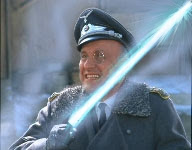
(source:LNER Encyclopedia)
The only 4-6-4 tender engine to run in Great Britain, Hush-Hush was the result of Gresley's experiments with high pressure water tube boilers, similar in type to those used in ships. The use of this boiler in a steam locomotive was not new, a number of others had been built by others (an American Company was the first), however this was the first time anybody had made an express-type locomotive to haul passenger services. Gresley's main reason for experimenting with the water-tube boiler stemmed from his wish to find a method of reducing coal consumption and a more efficient way of generating steam. At the time, the A1 Pacifics (not yet modified into the classic A3 model).
The locomotive was nick-named 'Hush-Hush' because of the secrecy of the project (although it is well known that probably everybody at Doncaster knew of its existence). Entering service in late 1929, the W1 ran around 90000 miles over the next six years, although a lot of time was spent fixing problems- out of the 1,888 days since it was built, No. 10000 spent 1,105 days in Darlington Works.
Gresley decided to re-build Hush-Hush as a conventional locomotive with streamlining in the style of an A4. In hindsight, this as probably an even wiser idea than it seems on first impression: with World War Two only a few years away, the unre-built locomotive would have been laid up with repairs for almost all the war years: during wartime, the standard of locomotive maintenece dropped off radically, and Hush-Hush required a lot of maintenance to keep it running.
As it was, the new locomotive resembled a larger and nameless A4. It was soon realised no.10000 was probably one of the strongest passenger locmotives in Britain: having an amazing 16% power incease over the already strong A4s. It gave excellent service on the heaviest passenger trains over the next twenty years (although little of its wartime use has been recorded apart from causing a few maintenance problems).
Surprisingly this one-off locomotive survived the early cuts of nationalistaion (among the casualties of standardisation were Bulleid's Leader and Stanier's Turbomotive, although it was rebuilt as a conventional locomotive). Somewhat more surprising was that it was passed over by Gresley's succesor, Edward Thompson for experimenting- given that most of Gresley's non-standard classes like the P2s were rebuilt into pacific styles or scrapped like the P1s.
No.10000 (renumbered 60700 in BR ownership) lasted until 1959, when it was finally cut up.
Was Hush-Hush a sucess? The answer is somewhat difficult to decide, much like the controversial 'Leader' design. Certainly no.10000 worked, and was recorded as being strong in both re-built and un-rebuilt form. As a more conventional locomotive it hauled revenue-earning trains for twenty years with a strong success rate. The unusual water-tube boiler did (after some modification) give good steam-raising and decent coal-consumption. The addition of a Kychlap exhaust on a recommendation from legendary French steam designer Andre Chapelon further increased its potency.
The downside: maintence took up most of its time, downplaying any costs saved in fueling. Also the unconventional boiler could not be easily fixed by normal loco works neccesitating use of Darlington works and further clogging up the maintenance schedules of the LNER. Also, there would be little use of a 4-6-4 tender engine like Hush-Hush except on long-distance passenger trains or frieght where the lack of continuous stopping and starting would keep the fuel efficiency high.
Had Hush-Hush been given more time it might well had succeeded further. But there would have been no way for Gresley to experiment in World War 2, and on his death in 1941 Thompson would have felled the unconventional type anyway. Nevertheless, it must surely rank as one of the more successful designs: if only because its rebuilt form lasted long enough to earn back the time and money spent in Darlington Works.




0 comments:
Post a Comment